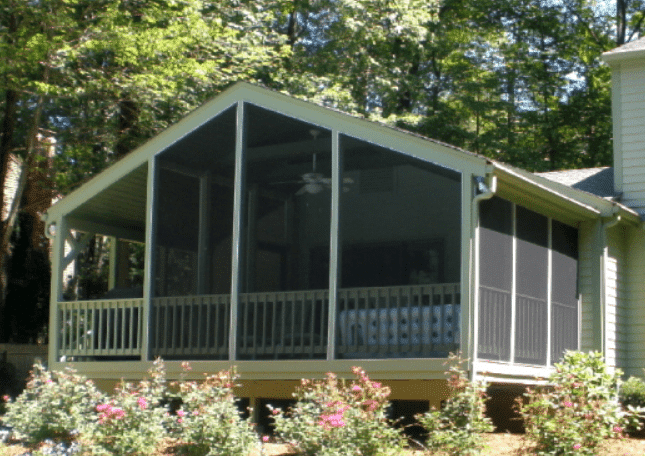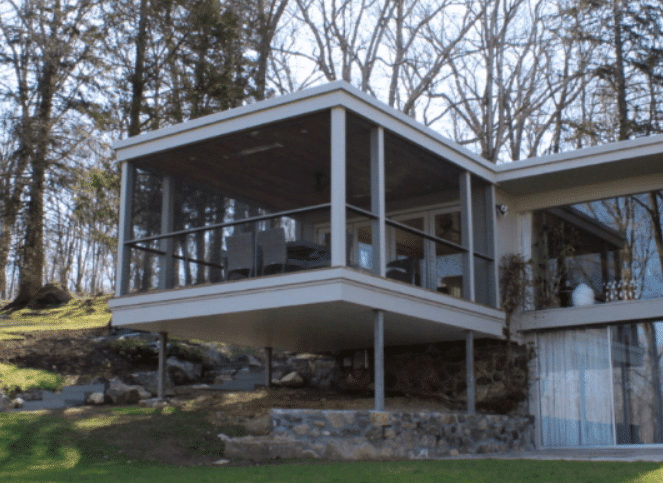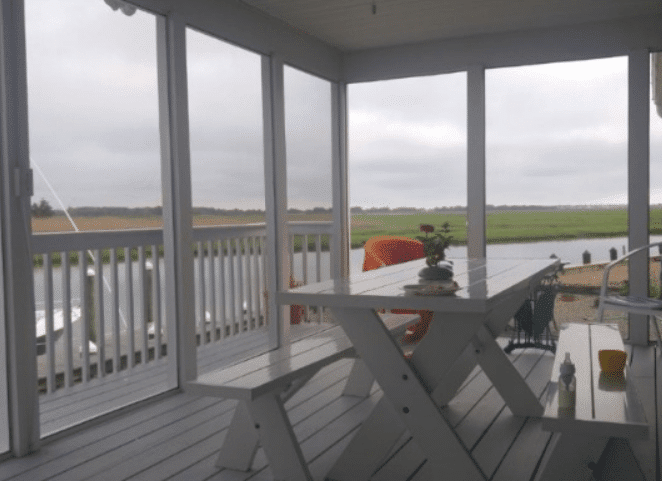A Guide to Outdoor Entertaining
Movie nights on the lawn. A lively game of volleyball. Intimate conversations in front of the outdoor fire pit. These things count as just a few examples of outdoor entertainment, and with the growing popularity of outdoor rooms, outdoor entertaining has grown more popular than ever.
Whether it’s a screened-in patio, an outdoor room, a covered gazebo, or a sitting area under the stars, a nice entertainment area outside allows you to extend the reach of your in-home entertaining areas. However, the outdoors also brings something unique and almost wild to the experience of entertaining.
On any given afternoon or evening, you might encounter butterflies floating above your rose bushes and squirrels rounding the trunks of your trees. The Great Outdoors also bring pests, like mosquitoes and more dangerous bugs, like hornets and wasps. If these elements aren’t accounted for, your outdoor party can go sour very quickly.
All of this is to say that successful outdoor entertaining is a balancing act. As host, it is up to you to set the stage for a magical evening, all while making sure that whatever nuisances might come your way be kept at a minimum.

Pre-Party Preparations
Setting the stage for your party ahead of time ensures that you and your guests will get the most out of your gathering. Of course, you’ll have to set up tables and chairs, food and serving items, and any décor items.
However, you also want to be mindful of the fact that your food and drink will attract bugs, like mosquitoes and yellow jackets. Make sure your party prep includes bug and pest prep.
Granted, some of your outdoor entertaining may not be completely outside…for example, if you’re holding your party in a relatively enclosed space, like a covered patio. However, even if that’s the case, it’s still a good idea to address this issue in case your guests wind up outside as the party progresses.
Bug Lanterns, Candles, and Other De-Bugging Methods
Bug lanterns zap the bugs in your yard into oblivion. You can position them on the outer perimeter of your yard. These options do have a drawback, however. They also kill good bugs, like bees.
Candles made from citronella or geraniol count as popular options. However, some lesser-known but equally pleasant-smelling substances work well as bug repellents. A dose of vanilla extract as well as sage and rosemary also do wonders. Most of these items smell good and add to the atmosphere of the party.
You can also do something as simple as placing a colander placed over your food can keep the bugs away, or you can just do a head trick on them- place sugar water or some other sweet thing at the perimeter of the yard.
Your Back Patio
Most backyards come equipped with some sort of patio, even if they don’t include any other type of outdoor “roomy” kind of feature, like a deck or a gazebo. The word “patio” comes from the same Spanish word meaning “back garden,” and this is a nod to the homes in Europe that have enclosed courtyards. Although many homes in the U.S. don’t have such a courtyard setup, that doesn’t stop most people from enjoying their outdoor spaces to the fullest.
The basic patio may just be a concrete slab, though many of the more elaborate ones also include materials, like river stone, bricks, and other luxury materials. Home construction usually includes patio access via a back or side door.
Some homebuilders construct some sort of roof or awning to cover the patio, though many remain open-air, with a flanking of bushes and other yard plants. These spaces often become the basis for many outdoor living rooms and/ or kitchens in their more elaborate forms.
In this form, these outdoor living areas may come equipped with full cooking spaces, including brick outdoor pizza ovens, barbecue grills, and gas stoves. Living room areas will include couches, fire pits, and other furniture items of this nature.
Additionally, some patio designs, like the “L-shaped” patio, connect the outer walls of two interior rooms, like the kitchen and the den to the outdoor living areas. Sometimes, this setup even includes a door to each of these spaces, and this increases the livable area exponentially.
However, these areas come in many shapes and sizes, including round, detached, and multilevel, all of which can be used in visually interesting ways to extend the space.
Finally, some patios fall into the screen-in porch/ patio category. Typically, a porch is constructed from the same materials as the house is, whereas the patio usually sits right on the ground and is often concrete.
Gazebos and Other Partially-Covered Outbuildings
Gazebos are as varied in their design as patios are. Some look like they belong in a painting, complete with white carved wooden pillars, wood floors, and open sides. Others come with curtains to keep the bugs away and to lend an air of privacy to the area.
It is possible to buy a gazebo at a home improvement store. This kind often has no base flooring, so any lawn furniture is placed directly on the grass or whatever other kinds of surface the backyard comes equipped with.
That said, the most elaborate gazebo constructions include some sort of foundation, solid ceiling support, and even enclosed walls in some cases. While many lack the power source that’s readily available to outdoor spaces, like an enclosed porch or patio, they are not without their advantages.
For one thing, many gazebos offer a certain kind of charm and emotional respite that other types of spaces don’t. They offer a shaded space, where a few armchairs, loveseats, and coffee tables find a home.
That said, for the ones that do have access to a power source, these outbuildings make an excellent home for another popular outdoor feature, the hot tub.

The Back Deck
In many urban areas, the back deck is a must-have. This backyard amenity is like a patio, with a more luxurious twist. Common deck materials include tropical hardwoods, cedar, redwoods, and aluminum to name but a few.
Typically, decks aren’t attached to the house in the same way that a patio might be, though a raised back deck may connect an upper-level backdoor to the outside and the backyard below.
Decks offer many advantages that some other types of outdoor spaces don’t. The ones constructed of wood offer the same homey vibe that a porch does, without the bulkiness of a porch. Some savvy yard designers also build decks with areas for plants, shrubs, and other outdoor amenities right into the deck.
Additionally, for the homeowners who really don’t like yard work but love spending time outdoors, a large back deck replaces the lawn area with something more manageable.
Backyard Porches
There’s something to be said for a good, old-fashioned porch. It’s a place where no one thinks twice about sitting and sipping on a glass of lemonade for hours, and activities might also include front-row seating to a summer thunderstorm or kids playing with fireflies after dark.
It’s this welcoming atmosphere that also makes them so appealing for entertaining. Many turn-of-the-century homes had wraparound porches that encircled the house on three or four sides. Some of these included screens, though many were open.
Nowadays, newly-built homes with back porches often come with enclosed porches, which makes entertaining very easy, especially from a bug perspective.
Bringing It All Together
Nothing quite beats bringing the party outside, especially during the first weeks after winter has finally broken and it’s warm enough to enjoy the outdoors. In the previous sections, we’ve talked a little about some of the most common types of outdoor spaces.
Anyone of these makes for a nice entertainment area. This section builds on the information in the previous sections and offers tips to make the most out of a home’s outdoor spaces.
First, let’s start with outdoor spaces, like patios, decks, and porches, which connect to the home’s interior, usually by a back or side door. These spaces more easily convert to genuine outdoor living areas in large part due to their close proximity to the house.
When you extend your living area past the confines of your home’s interior, there is often an effort to tie the outside space with the inside space, at least from a visual standpoint, though there is usually a connecting door as well.
Savvy homeowners who want to provide visual continuity between their outdoor space and their indoor space have a couple of options:
- Paint the outside walls the same color as the inside walls
- Continue a brick pattern from an interior wall or a tile pattern from an interior floor into the outdoor space
- Buy accent items, like pillows, throw blankets, tablecloths, etc. to match both spaces
- Replace single doors with double French doors to completely open up the wall between rooms, like the living room/ family room and patio
Make a Pool Area More Comfortable
Some outdoor living spaces convert easily into lounge areas for outdoor water features, like pools and hot tubs. As we’ve already discussed, many gazebo owners use their gazebo as a place to house their hot tub.
However, a gazebo isn’t necessary. Any back deck, patio, or porch by a pool becomes lounge area by adding some comfortable chairs, sofas, and benches. If these items will be openly exposed to the elements – that they will be out under the open sky – you’ll want to get furniture that is upholstered for outdoor use.
This is especially true for the furniture that will sit near a pool or hot tub: The water may ruin the furniture after too many exposures.
Seating Areas and Other Concerns
Outdoor living rooms and kitchens usually have some type of seating that’s separate from the seating in the house. In the outdoor kitchen area, items like a dining table and side tables or benches expand the space. The chairs provide more seating for guests.
In an outdoor living or lounge area, comfortable cushions, extra throw blankets, and even an open fire pit/ coffee table add a great deal to the ambiance. Homeowners who add features, like open fires should be mindful of safety. Not only do these areas need fire extinguishers, buckets of water, and that sort of thing, but the line of traffic should be very clear.
If there is a fire pit that’s flanked by couches and chairs, a clear walkway should be made. This is particularly true if the fire pit is dug into the ground instead of being nested inside a raised fire pit, like the coffee-table-style fire pits. Additionally, the seating should be positioned far enough away from the pit to provide ample room for walking and to mitigate flying sparks.
Finally, a fire pit that is deep within the ground should be situated away from areas that are in the middle of the lawn. There are just too many dangers inherent in this setup.
As for the amount of seating, you can expand the seating area by spreading blankets out if there isn’t enough seating. Lawn chairs that guests bring and of course, seating in the house also provide seating options.
Some homeowners may shy away from such an arrangement, but it’s okay to be casual in not only the seating arrangement but in everything. Mismatching or paper dishes are perfectly acceptable to use when entertaining outside, and in the case of the paper dishes, clean-up afterward goes by a whole lot easier.

Food and Drink
Finally, it’s not a party without food. The easiest outdoor parties feature go-to items, like salads, fruit, grilled items, and brewed iced tea. As well, guests can contribute their own dishes to add variety to the meal.
Hosts who want to encourage mingling can do so in large part by how they set up the food areas. Putting snacks and drinks and dinner in separate areas allows people to chat it up while they’re serving themselves. The host can further encourage mingling by bringing around appetizer platters and drinks and introducing guests to one another.
Finally, drink carts allow for easy drink refills when supplies run low. You only need to push the cart back into the kitchen or pantry to restock it. An outdoor fridge with an ice cube maker makes this setup easier as well.